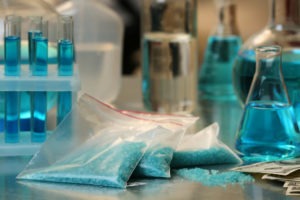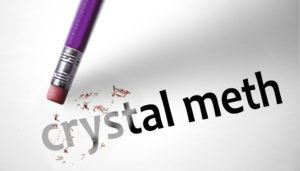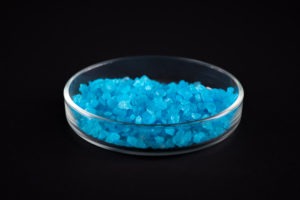Addiction | 4 min read
Crystal Meth – Drug Detox and Addiction Treatment Facts
Medically Reviewed By

On August 30, 2022
Written By
On September 25, 2020

Crystal meth addiction has become a growing problem in the US, with an estimated 2.6 million people using methamphetamine in the past 12 months in 2020. The effects of meth addiction can be devastating, and the need for professional treatment help is real. Crystal meth detox and addiction treatment centers address the physical, emotional, and psychological challenges recovering addicts face in recovery.
What Does Crystal Meth Do?
Crystal meth, short for crystal methamphetamine, is a form of the stimulant methamphetamine. As one of the most powerful stimulants, methamphetamine works by speeding up the body’s central nervous system. It does this by forcing the brain to produce large amounts of dopamine, norepinephrine, and serotonin chemicals. These chemicals play central roles in regulating your emotions and thinking.
Crystal meth may appear as a white powder or in white crystalline form. Users snort, smoke, or inject it. Meth’s addictive properties stem from its ability to change the brain’s chemical system gradually. As it does this, your brain becomes more dependent on the drug to function normally. These developments account for why crystal meth addiction is so hard to overcome. Other slang terms for crystal meth include crank, chalk, ice, glass, and speed.
The Path from Dependence to Crystal Meth Addiction
Dependence
Using crystal meth regularly sets in motion a series of chemical and physical changes in the brain. First, with each dose of meth, the brain’s cells become less sensitive to its effects. When this happens, your tolerance for meth has increased. Unfortunately, this means you’ll have to take larger and larger doses of the drug to keep experiencing the desired effect.
As tolerance levels increase, your brain depends on meth’s effects to produce dopamine, norepinephrine, and serotonin instead of doing it on its own. At this point, the brain has become physically dependent on meth. Once physical dependence takes hold, you can expect to experience signs of meth withdrawal whenever your needed amounts of meth are lacking. Signs of meth withdrawal include:
- Fatigue
- Insomnia
- Depression
- Anxiety
- Increase in appetite
Addiction
The combined effects of increasing tolerance, physical dependence, and signs of meth withdrawal set the stage for crystal meth addiction. Meth’s effects on dopamine output, in particular, account for why this drug is so addictive. You experience feelings of calm, happiness, and contentment whenever dopamine levels increase. Also, dopamine works with your brain’s reward system, the area of the brain that determines your behaviors and what motivates you.
When something you’re doing causes dopamine levels in the brain to increase, that particular activity becomes “hard-wired” into the reward system. In this way, your reward system drives your behaviors based on the rise and fall of dopamine levels. Since crystal meth causes dopamine levels to skyrocket, getting and using the drug quickly takes on top priority in your life when you abuse it. At this point, you are willing to risk anything and everything to keep getting and using crystal meth.
The Crystal Meth Detox Process
What to Expect During Crystal Meth Detox
Once you stop taking crystal meth, your nervous system “crashes” since it’s left to fend for itself. Your brain relies on meth’s effects to keep it running, so your body’s systems will start to experience problems. Signs of meth withdrawal develop because of these developments.
These conditions bring on considerable discomfort, making it extremely difficult not to take meth again. For these reasons, it’s important to have the supports you need to make it through the crystal meth detox process. Meth detox centers provide round-the-clock monitoring, emotional support, and medical care to help your brain and body re-learn how to function without meth’s effects.
The Crystal Meth Detox Timeline
Crystal meth detox affects each person in different ways but there’s a general timeline that plays out in most cases:
- Days one to three – This is the “crash” period. Expect to experience irritability, depression, drug cravings, vivid nightmares, and lots of sleeping.
- Days four to 11 – Withdrawal symptoms tend to be more mental and emotional around this time. These symptoms include feelings of paranoia, hallucinations, anxiety, and an inability to feel pleasure or joy. In addition, it’s at this phase where drug cravings will be at their worst.
- Post-Acute Withdrawal – While not everyone goes through this phase, people coming off heavy meth use will experience it. During this time, your brain is healing and repairing the damage left behind by meth use. Symptoms experienced include problems with concentration, confusion, depression, ongoing meth cravings, and problems sleeping. The post-acute withdrawal phase can last anywhere from three to six months.
So How Does Crystal Meth Addiction Treatment Work?
The effects of crystal meth addiction create problems in almost every area of a person’s life. The brain has essentially been rewired to the point where the compulsive need for the drug drives users to neglect all other areas of their lives. More than anything else, treatment for meth addiction focuses on helping you create a drug-free lifestyle.
While treatment services vary from program to program, here are just a few of the interventions likely to be offered:
- Behavioral therapies
- Support groups
- Family therapy
- Individual psychotherapy
- Relapse prevention training
Depending on the severity of your addiction, inpatient, residential, and outpatient treatment programs offer different levels of support. Inpatient programs treat the most severe cases where mental health issues and medical problems exist alongside a meth addiction problem. Residential programs also take place in live-in treatment centers where residents learn the types of day-in and day-out habits that support a drug-free lifestyle.
If you’re struggling with crystal meth addiction, drug addiction, or alcohol addiction, the time to seek treatment help is now. When left untreated, meth addiction continues to spiral out of control, destroying relationships and families while leaving a shell of a person in its wake. Crystal meth detox and addiction treatment can provide the support you need to take back your life from addiction’s control. So call the Ascendant admissions line today and learn more about our medication-assisted treatment for substance use disorder.
Was this article helpful? Follow our blog for more information about substance use, addiction, and recovery. Recent posts include topics such as the effects of smoking weed every day and alcohol rehab at Ascendant.
Ascendant New York Editorial Guidelines
Here at Ascendant New York, we understand the importance of having access to accurate medical information you can trust, especially when you or a loved one is suffering from addiction. Find out more on our policy.
- National Institute on Drug Abuse. What is the scope of methamphetamine use in the United States? National Institute on Drug Abuse. Accessed August 30, 2022. https://nida.nih.gov/publications/research-reports/methamphetamine/what-scope-methamphetamine-misuse-in-united-states
- Hartney E. An Overview of Meth Withdrawal. Verywell Mind. Published April 3, 2020. Accessed August 30, 2022. https://www.verywellmind.com/meth-addiction-causes-effects-treatment-5666979
- Zorick T, Nestor L, Miotto K, et al. Withdrawal symptoms in abstinent methamphetamine-dependent subjects. Addiction. 2010;105(10):1809-1818. doi:10.1111/j.1360-0443.2010.03066.x





